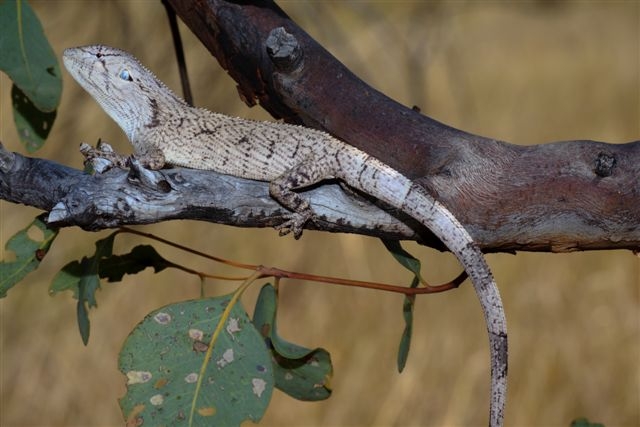Ngalwalngurru
Chameleon Dragon
September 13, 2012
photo ©: Australian Wildlife Conservancy/Andrew Morton
Nawu Warddeken kabirridurrkmirri, birringalkeng mayh nawu karringeybun ngalwalngurru. Yika mak kabirringeybun mak alwalngurru (Kundedjnjenghmi) dja walwalngurru (Kune). Konda kayolyolme Nabangardi Nabordoh ngalekke mayh alwalngurru.
The Warddeken rangers found a chameleon dragon which is called alwalngurru in Bininj Gunwok. This is its name in Kundedjnjenghmi but it is also called walwalngurru in Kune. In this post you can hear Nabangardi Terrah Guymala talking about this lizard which is culturally important for bininj.
But first how to say the name:
Bale karriyime karringeybun? al-wal-ngurru
Nabangardi Terrah kayolyolme alwalngurru-ken:
Nabangardi Terrah talks about the chameleon dragon. Follow the transcript below.
[00:00:05.08] yoh, njamed ngalwalngurru
yes, whatsit, the chameleon dragon
[00:00:09.10] kangeyyo namenge mayh
that's what this animal is called
[00:00:11.08] ngalwangurru, name kukbameng
the chameleon dragon has a light coloured body
[00:00:15.17] yika njamed ka-kurlah...bikahmen bu ngamed kore
and sometimes it can change its skin colour when its on
[00:00:22.21] bale karriyime nameke kurrulk o kuwardde
what is it, when its on a tree or a rock (changes to the colour of the background)
[00:00:25.00] sometime change kayime
sometimes it can change itself
[00:00:25.24] bad nameke ngalwangurru nakka bedberre djang
but the chameleon dragon is a totemic emblem for them
[00:00:29.00] bthe people from the Djordi clan and the sacred site for it is upstream in the Kodwalewale estate
the people from the Djordi clan and the sacred site for it is upstream in the Kodwalewale estate
[00:00:33.05] dja Nabelan kunred kayimarnedjangdi
an estate also referred to as Nabelan, that is the place where the sacred site is located
[00:00:38.20] alwalngurru ngalekke
she is the chameleon dragon
[00:00:41.07] djang
a totemic emblem/sacred site
[00:00:41.19] en korrokoni konda ngarridi ngarrinani bu ngarrimwam
long ago when we came here we used to see them all around wherever we went
[00:00:45.24] konda kaberrkdi kore redwakbuni bad bolkkime ngarriyawam
here they were everywhere running around the place but today we had to look hard for one
[00:00:49.12] bad ngarringalkeng wanjh boyen ngarriwam manekke ngamed
but we did find one and recently when we went to what's that place, um
[00:00:54.02] Ngangkan ngarrihyoy Ngurlken ngarridurrkmirri warridj kume ngarringalkeng
we went to Ngangkan, camping out for a few days, and we were working there also and we found one
[00:00:59.23] wanjh kahdi wanjh ngarrinjilngmakminj mane mak nawu birri-bih...
when we found it we felt glad because they
[00:01:02.05] nawu, nawu djang birridjangweleng birrinjilngmakminj bu birrinang
those people who are the owners of this totem, they felt very happy to see it
[00:01:05.12] karra-, karrarrkiddi
still alive and well
[00:01:07.15] bu name kayakmen wanjh njale wurdurd nawu birri-, birri-, birri-bika nawu kabirrimre nanih nawu
but if it was ever to disappear, then the next generation of children who grow up
[00:01:12.03] wurdurd nawu yiman kayime Bulanjngong
those children of the Bulanj subsection
[00:01:14.20] nawu kabindiyawbornan o Ngarridjngong yerre minj
whose fathers are of this clan or maybe all the Ngarridj subsection people, then they would not
[00:01:16.23] kabindimarnemulewan korre nani djang kadberre (ngunkurrmi?) njale djang ngarrkukwakwan
be able to tell those children about that sacred site and that totem, "what totem, we know nothing about it" (they would have to say)
[00:01:20.07] bad manek important to keep them alive, so we can tell story
so that's why it's important to keep them alive, so we can tell its story
Credits: All recordings by Alys Stevens, Biodiversity Conservation Unit, Northern Territory Government.
Bonj
That is all.